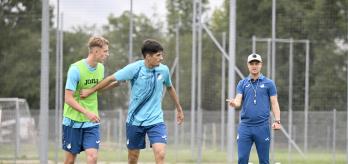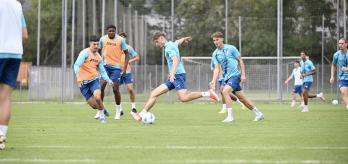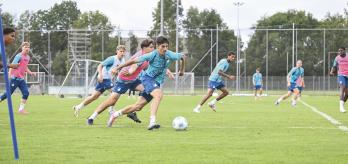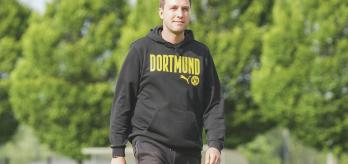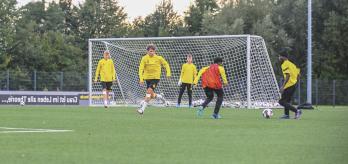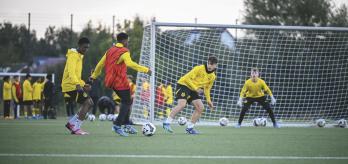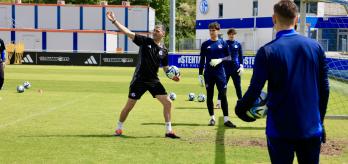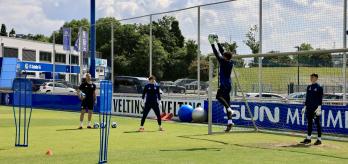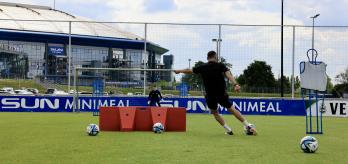This session for the Schalke U-19 team, led by goalkeeping coach Volkan Ünlü, focuses specifically on goalkeeper training. It concentrates on intercepting crosses and transitioning swiftly to ensure that play remains dynamic. The exercises have been designed to hone technique, improve the decision-making process and help goalkeepers to react more quickly.
Warm-up
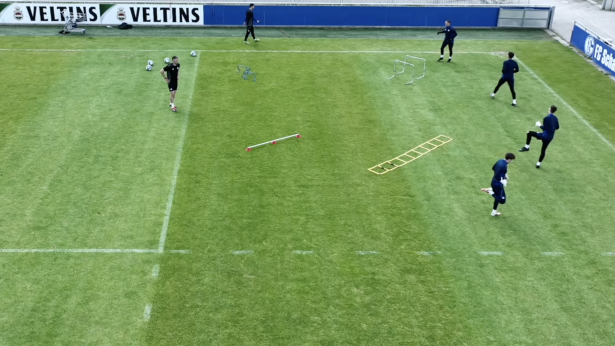
The session starts with a six-minute warm-up, where the goalkeepers work in a small area with balls and various pieces of equipment.
-
Within a 16m x 16m exercise area, distribute 2 large hurdles, 3 small hurdles, an agility ladder and a horizontal bar set near the ground.
-
The players can move anywhere in the 16m x 16m exercise area, using the equipment provided to warm up physically and technically.
-
Each player then receives a ball and can dribble anywhere in the 16m x 16m exercise area, continuing to incorporate the equipment into their movements.
-
When instructed to do so by the coach, the players juggle the ball and then do some quick, individual stretching.
-
The four goalkeepers then pass two balls between themselves as they move around the equipment in the playing area.
Goalkeeper activation
Next comes a more specific part: five minutes of throwing and passing through channels to get the goalkeepers ready for the session.
-
Mark out a 12m x 32m exercise area.
-
Set up 4 mannequins in a row across the middle of the exercise area.
-
Divide the 4 goalkeepers up: Two pairs of goalkeepers face each other, separated by the mannequins.
-
The 4 goalkeepers pass balls through the gaps between the mannequins, taking no more than three touches.
Variation 1:
-
The 4 goalkeepers chip the balls to each other over the mannequins, alternating between passing with left and right feet.
Variation 2:
-
The goalkeeping coaches hold the balls in front of the goalkeepers. On cue, the goalkeepers grab the ball and attempt to throw or roll it accurately to the goalkeeper in the other half of the exercise area.
Catching, rolling & throwing
In the first main part of the drill, the focus is on counter-attacking after a corner. The goalkeepers start by catching high balls and, on the goalkeeper coach’s call, have to roll and later throw the ball to a designated dummy. This is followed by shots on goal.
-
In front of the goal with the goalkeeper, set up 6 mannequins as shown.
-
Use coloured bibs or cones to set the mannequins apart.
-
Position goalkeeper 2 and goalkeeper 3 to either side of the goal and goalkeeper 4 at the penalty spot, each with a supply of balls.
-
Goalkeeper 2 then launches two high balls into the six-yard box, which goalkeeper 1 jumps to claim.
-
After catching the second “corner”, goalkeeper 1 transitions immediately by running forwards with ball in hand.
-
The coach calls out a colour (e.g. “blue!”).
-
Goalkeeper 1 rolls and later throws the ball to the corresponding mannequin.
-
Goalkeeper 1 runs back to the middle and waits behind the two central mannequins.
-
If they hit the right mannequin, they face two high volleys and a bounce ball from goalkeeper 4.
-
If they hit the wrong mannequin, they face two high volleys.
-
If they missed the mannequins altogether, they only face one high volley.
-
Play continues with goalkeeper 3.
-
After a while, swap positions.
Variation (throwing) -
If they hit the right mannequin, they face one shot near to the body, a bounce ball and a low shot from goalkeeper 4.
-
If they hit the wrong mannequin, they face one shot near to the body and a low shot.
-
If they missed the mannequins altogether, they only face one low shot.
Moving to the ball:
-
Step off using the foot further from the ball.
-
Focus on the ball and find the most direct route to it.
Jump phase:
-
Take off with an explosive movement with the leg closer to the ball, with the other leg swinging to provide support.
-
Your arms support this movement, thrusting towards the ball.
Grabbing the ball:
-
The arms/hands should be in position to receive the ball in front of and above the head, while you look ahead and up.
-
Extend your body in mid-air and pull up the swinging leg.
-
Keep your shoulders at right angles to the flight of the ball.
-
Use your hands to form a triangle around the ball.
Claiming the ball:
-
Let the ball fly into your hands, grab and pull it towards your chest and land on both feet.
Moving with the ball:
-
The leg further from the ball (supporting leg) initiates the movement.
Reaching to throw:
-
Bring your throwing arm backwards.
-
The foot of the supporting leg points in the direction you roll the ball.
-
The throwing arm gains momentum just before you plant the supporting leg.
-
Lean your upper body slightly forwards, over your knee.
Roll phase:
-
Lower your centre of gravity.
-
Bring your throwing arm down and roll the ball low and hard.
Final phase:
-
Follow through with your rolling arm.
Moving with the ball:
-
First, take a cross-step using the leg further from the ball.
Reaching to throw:
-
Bring your throwing arm backwards to gain momentum.
-
Push the supporting leg (i.e. the leg that is further from the ball) ahead of your body as you start to turn.
Throw phase:
-
Take a decisive step forwards with your foot pointing in the direction of the throw.
-
Just before planting the supporting leg, turn your knee and hip towards your throwing arm side.
-
Use your shoulder and arm to “hurl” the ball.
Final phase:
-
Follow through with your throwing arm.
-
If fewer goalkeepers are available, play is restricted to one side and the goalkeeping coach assumes the tasks for goalkeepers 2 and 4.
Searching for the second or third wave
The session ends with a complex drill: after catching a high ball, the keeper must react to two rolling balls and red/yellow cone gates simulating counter-attacking runners, with the coach assigning a target player.
-
In front of the goalkeeper, set up 6 mannequins, a rebound board and 2 triangles as shown.
-
Position goalkeepers 2 and 3 on the corners of the penalty area, each with a gym ball, and goalkeeper 4 halfway between the triangles with a supply of balls.
-
The coach also has some balls in the corner.
-
The coach crosses into the penalty area for goalkeeper 1 to catch.
-
Goalkeeper 1 transitions immediately by running forwards.
-
Goalkeepers 2 and 3 each roll their gym ball into the channels between the mannequins.
-
Goalkeeper 1 must listen to the coach’s instructions and react quickly:
-
“White”/“blue” = Hit the white/blue gym ball (third wave).
-
“Red”/“yellow” = Bypass two lines by throwing through the triangles (second wave).
-
-
One successful throw ends the sequence.
-
After a while, swap positions and deliver the corner from the other side.
If goalkeeper 1 is unsuccessful, goalkeeper 4 has the following options:
-
Dribble and shot from a deeper-lying position
-
Pass to the feet of goalkeeper 2 or 3, who then dribbles and shoots
-
Pass into the path of goalkeeper 2 or 3, who then plays a square ball to the other goalkeeper in the penalty area
-
If fewer goalkeepers are available, execute the training session with just one gym ball.



